(MENAFN- Asia Times)
The most angrily emotive Russian bugbear of its war in Ukraine was aired before the eyes of the world last week by Moscow's Foreign Minister Sergei Lavrov.
Speaking at a televised press conference on March 10 after his abortive meeting with Ukrainian Foreign Minister Dmytro Kulebain in Turkey, Lavrov was grilled about one of the worst atrocities of the carnage: the bombing by Russian forces of a maternity hospital in the city of Mariupol.
For those curious about one of the stated aims of Russian President Vladimir Putin's invasion of Ukraine – to“denazify” the country – Lavrov's response provided insight.
Lavrov claimed that“the ultra-radical Azov Battalion” and“other radicals” drove women and children out of the hospital and took up positions there. His implication was the alleged use of the hospital for military means justified the use of Russian artillery.
Lavrov's claims were contradicted by Ukrainian TV footage that clearly depicted pregnant women at the facility. Kiev said three people, including a child, were killed in the Russian strike.
Kulebain was scathing about Lavrov's response. Russian officials“live in their own reality,” he said . International TV media, who possibly did not comprehend what the Russian foreign minister, or his translator, was alluding to, lambasted Lavrov's response.
Asia Times cannot confirm Lavrov's veracity, or otherwise. But TV images do not necessarily negate his ''j'accuse” – that troops may have been using part of the hospital as a position.
In fact, exactly the tactic that Lavrov alleged in Mariupol was recorded during combat involving Azov forces in the Donbas.
A 2016 report by the Office of the United Nations High Commissioner for Human Rights Report, “On the human rights situation in Ukraine 16 November 2015 to 15 February 2016,” documented“extensive use of civilian buildings and locations by the Ukrainian military and the Azov regiment … armed groups and Ukrainian armed forces also continued to position military forces in or near hospitals.”
While multiple analyzes of this war's casus belli focus on cold, hard geopolitics – NATO expansion, Russia's sphere of influence, national sovereignty – darkly emotive nationalist devils lurk in the background shadows.
Given Ukrainian President Volodymyr Zelensky's Jewish background, and his clear democratic mandate, many around the world have jeered at Putin's references to“denazification.”
Yet when it comes to Russo-Ukraine relations, references to neo-Nazism are not entirely without basis. They harken back, past the post-2014 Russo-Ukraine conflict, to the bloodiest front in the world's bloodiest war.
To its grave misfortune, Ukraine bestrides a blood-red meridian. Its vast flatlands provide a perfect east-west invasion corridor, and its rich black soil is coveted by neighbors. In the 1930s and 1940s, two of the world's most murderous regimes – Stalin's Communist USSR and Hitler's Nazi Germany – conducted war and genocide over the country.
These complicated and bloody histories, intertwining extreme ideologies with violent nationalism, are little known in the West. Related animosities were effectively suppressed during the Soviet era, but were fanned back to ferocious heat after the implosion of the USSR and the rise of new states around the perimeter of the Czarist/Soviet empire.
Hard rightism returned. In Ukraine, some groups and politicians sought to rehabilitate Stepan Bandera, a hardcore Ukrainian nationalist who cooperated with the Nazis, and whose militia massacred tens of thousands of Poles and Jews in a particularly savage manner.
And as combat spread across Ukraine's Donbas, rightist militias emerged. Some were neo-Nazi in orientation and drew white supremacist volunteers, often of dubious backgrounds from across the world. The highest-profile among these was Azov – described as an“extreme rightist nationalist paramilitary” by Stanford University .
The unit is no longer a militia. It has been incorporated into Ukraine's official armed forces. Western observers of the ongoing war may have mixed feelings about Azov's presence in the frontline – is it, or the invader, the“lesser of two evils?”
For Russia, Azov has resurrected the furies of the 1940s by associating itself with the most notorious organization of Adolf Hitler's Third Reich.
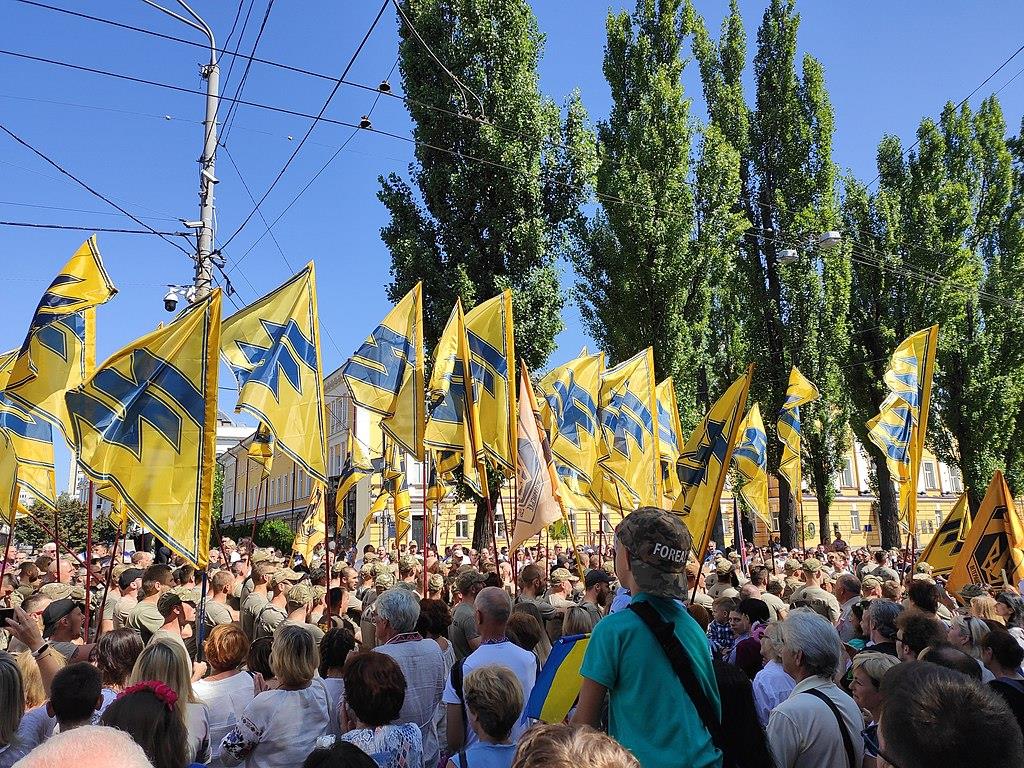
A march past of Azov troops, displaying their unit banner featuring the wolfsangel symbol. Photo: WikiCommons
Ukraine's far-right war band
In May 2014, the unit emerged in Mariupol, a city on the Avov Sea – hence its name. Its early members reportedly came from the ultra-nationalist Patriot of Ukraine gang, and the neo-Nazi Social National Assembly. Its raison d'etre was combat – as a Ukrainian militia unit fighting Russian separatists.
That conflict arose after the overthrow of pro-Russian president Viktor Yanukovych during the people-power Euromaidan protests that triggered a seismic change. Ukraine was dragged out of Russia's sphere of influence, to the alarm of Moscow and many ethnic Russians in Ukraine – particularly given the appearance of far-rightists in and around the protests.
Subsequently, predominantly Russian Crimea was annexed by Moscow. But the Donbas conflict, fueled by ethnic nationalism on both sides, rumbled on. It lured volunteers from across Ukraine, the Russian Federation and further afield. Militias on both sides coalesced around charismatic leaders.
One was Andriy Biletsky, a hardcore Ukrainian nationalist who had been imprisoned for political violence in 2011. He founded Azov and then the far-right political party, the National Corps. Representing that group, he entered mainstream politics and occupied a seat in Ukraine's parliament from 2015 to 2019.
Though Michael Colborne, the author of a 2022 book on Azov, notes unproven allegations that Azov has connections to Kremlin spy agencies – which would suggest an incredibly shadowy“black flag” operation – there is no doubt that Azov played a key role fighting to eject Russian separatists from Mariupol in 2014. It then battled them, for years, in Donbas.
At a time when Kiev's regular military was weak, the unit, and other militias, won funding from Ukrainian oligarchs. In November 2014, Azov was officially incorporated into the Ukrainian National Guard as a“special purpose regiment.”
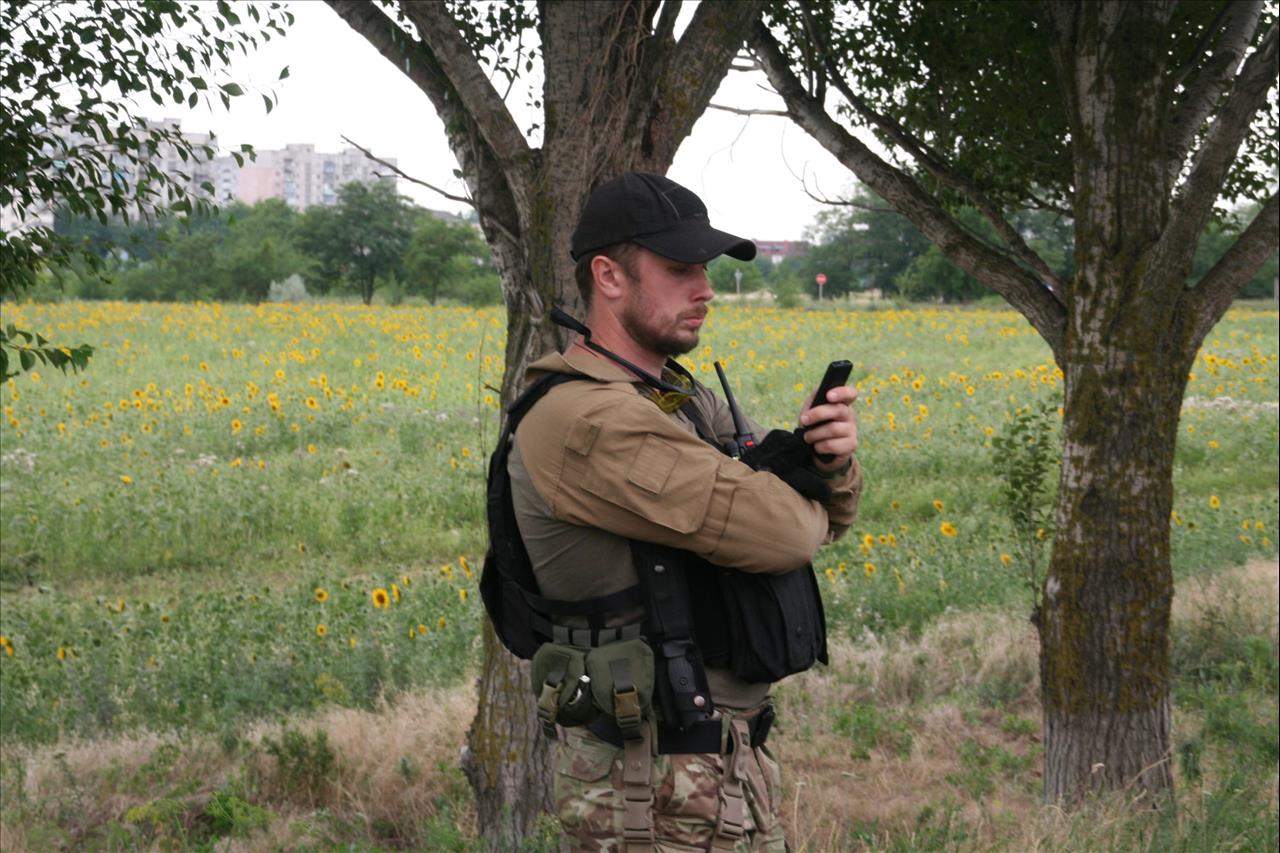
Azov founder and hard-right politician Andriy Biletsky on patrol near Mariupol, date unknown. Photo: Wikimedia Commons /Carl Ridderstråle
Azov proved effective in battle. In the Donbas, its troops became a kind of quick-reaction force to assist embattled Ukrainian regulars . Petro Poroshenko, an admirer of Bandera who preceded Zelensky as president of Ukraine, said at an award ceremony in 2014 that Azov are “our best warriors.”
Still, it smelled rotten to Western noses.
When NATO started training and supplying a new-look Ukrainian military, Azov was persona non-grata. The US Congress banned them from receiving US funds in 2018 – the same year Canadian officers were embarrassed to attend a briefing during which Azov members were present.
The reason for Azov's notoriety is clear for all to see.
Symbology of genocide
Azov's logo, seen on uniform patches and banners, is an ancient Germanic symbol, the wolfsangel – a design based on metal wolf traps. Historically, the wolfsangel featured both on coats of arms and on banners of peasant rebels and guerilla resistors but gained notoriety in World War II as a symbol of multiple German units.
Granted, the wolfsangel predated the Third Reich, and some members say they are not neo-Nazis, but followers of ancient European, Nordic and pagan traditions.
Yet Azov's deployment of Nazi symbology does not stop there. Unit members have been photographed sporting tattoos and helmet patches featuring swastikas – the Nazi Party symbol – and SS runes on their uniforms.
And in the Third Reich, the wolfsangel was married to SS runes when it was adopted as the unit symbol of the 2nd SS Panzer Division“Das Reich.”
The SS expanded from Adolf Hitler's close-protection detail (Schutzstaffel) into a vast organization that drew the most fanatical Nazis. Its units carried out mass murder in the form of a murderous anti-partisan campaign across the USSR, and genocide in the Holocaust.
While the 2nd SS was a combat unit, rushed from one frontline crisis spot to another, it also carried out atrocities – including the murder of Jews in Minsk and the liquidation of the French village of Oradour.
Dubbed a“criminal organization” at Nuremberg, the SS is widely reviled by mainstream historians worldwide. However, a minority fandom exists globally that admires the dark glamor of SS uniforms, symbols and kit, and still praises its struggle against communism.
This fan base includes neo-Nazis.
“I guess groups like the Azov Regiment glom on to these kinds of symbols because they are symbols of power and military prowess,” Douglas Nash, a former US Army officer who has written scholarly histories of the SS told Asia Times.“Given how Russians perceive such symbols, it plays into the hands of the Putin propagandists.”
(An editorial aside: Due to the sensitivity surrounding neo-Nazism, related images are often deleted from websites for fear of causing offense – a process that many historians decry. Hence, these photographs cannot be reproduced within this story, regardless of their value for the journalistic record.)
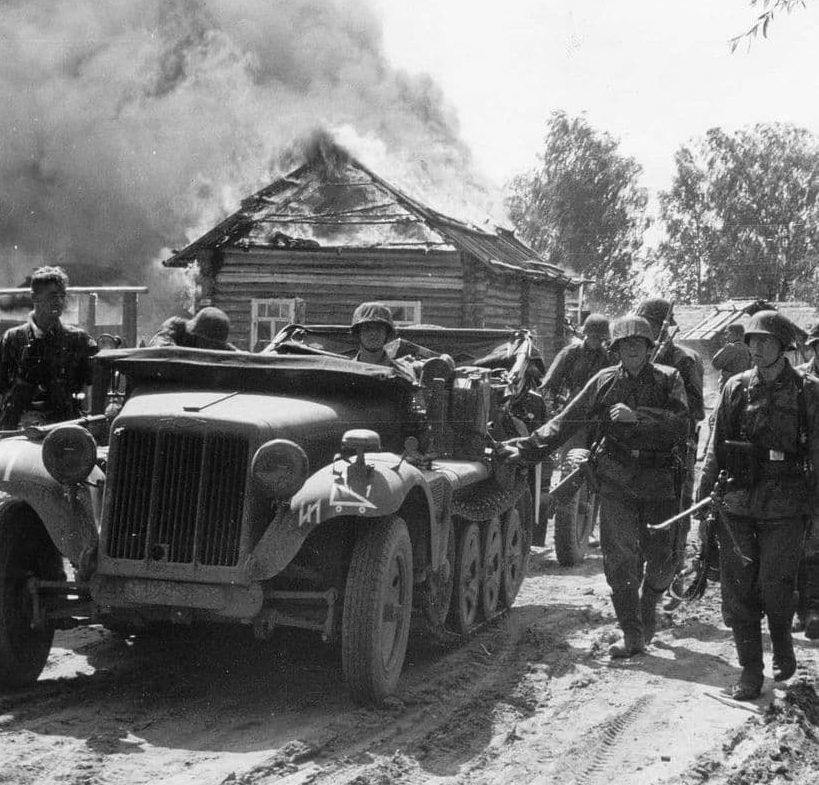
A unit of SS troops of the“Das Reich” division move through a burning village. Note the wolfsangel symbol on the fender of the vehicle. Photo: Courtesy Richard Richard Deveau-Maxwell
'Black plague' vs 'Red Plague'
Still, in parts of Eastern Europe, rolled over by the black-uniformed troops of Hilter and the red-starred troops of Stalin, there is nuance surrounding World War II – even the SS.
After Stalin had overseen murderous famines in Ukraine that killed 3-5 million in 1932-33 – the Holodomor – some Ukrainians welcomed German invaders as liberators. Even though the Nazis considered Slavs untermensch – subhumans – complex loyalties entered play.
As Germany was battled to a standstill by the Red Army, it desperately raised SS divisions in conquered territories, including the Baltic States and Ukraine.
In both those locations, Moscow faced post-war partisan struggles. The insurrections were extinguished by 1950, but in the post-Soviet era, some SS units and partisans were rehabilitated.
Take Bandera, a radical Ukrainian patriot who sought contacts in Nazi Germany – before his nationalist agenda led them to imprison him in a concentration camp. But as the war turned against Germany, Bandera was released to lead an insurgency as the Red Army surged west.
It was a hopeless struggle. Bandera fled, and, after being courted by Western intelligence agencies, was eventually assassinated by the KGB at his home in West Germany in 1959.
Though Bandera's troops massacred Poles and Jews – often in conditions of utmost brutality, using farm implements – his reputation has been reassessed by some in recent years.
His face has appeared on banners at street marches and the torchlit parades that Azov specializes in, a monument has been raised in Lviv and Ukraine's current ambassador to Germany tweeted that he had laid flowers at the Munich grave of Bandera,“our hero,” in 2015.
Granted, these sentiments are far from universal across 2022 Ukraine.
Polls show mixed feelings toward Bandera. Attempts by some politicians to grant him posthumous hero status were turned down by the Ukrainian parliament in 2019, the same year that far-right parties won less than 2% of the national vote in parliamentary elections.
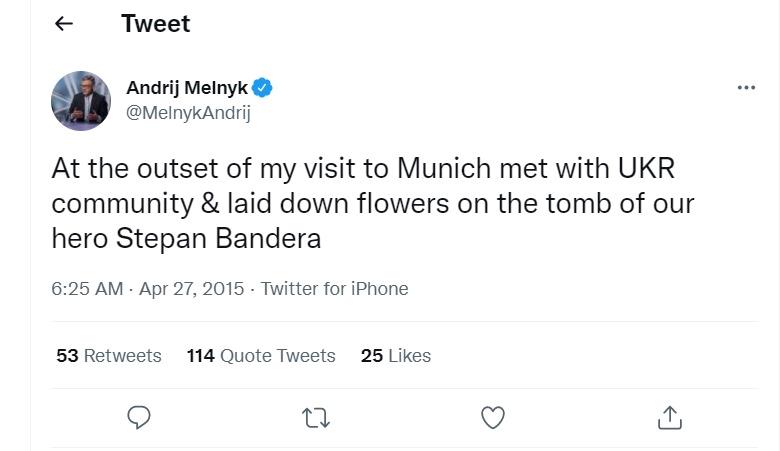
A Tweet from the current Ukrainian ambassador to Germany makes clear his feelings for the highly controversial historical figure, Stepan Bandera. Photo: Twitter
New right impunity
While no commentators outside Russia would paint the majority of Ukraine's current-generation defenders in neo-Nazi colors, Avoz has operated with apparent impunity.
And it is about far more than symbology and revivalist nationalism. Many soldiers profess far-right, white-supremacist sentiments. In 2015, a spokesperson for the regiment admitted that 10% to 20% of Azov's recruits were neo-Nazis.
According to a 2021 investigative report by Time news magazine, Azov spawned a political party, two publishing houses, summer camps for children and a vigilante force known as the National Militia. Nationalist vigilantes in Ukraine have, in recent years, attacked two targets of both old- and new-school Nazis: Roma and LGBTQs.
The current activities of these forces were reported by journalist Dmitry Kovalevich, a member of a banned communist organization in Ukraine, to Asia Times earlier this month.
While Kovelevich, who lives south of Kiev, is not a disinterested source – his comments support Russian separatism in Donbas – his claims jibe. He said he offered shelter to Roma, who were fearful of far-right vigilantes manning checkpoints as they sought to flee to western Ukraine.
“I feel quite nervous,” Kovelevich, added, referring to“the terror of [right-wing] nationalist gangs.”
Time magazine reported that Azov affiliates spread the manifesto of the 2019 Christchurch killer, and the unit has been the subject of Congressional inquiries and investigations by Facebook. At a US request, Kiev took action in 2019 and deported two American neo-Nazi members of Azov.
More broadly, the report suggested that the overall Azov movement had incubated and trained an underground, global cadre of combat-hardened white supremacists. And Russian Foreign Minister Lavrov last week said:“These units are trained to commit terrorist acts.”
That accusation may spark remembrances of one of the West's biggest policy errors of recent history, leading to the coining of the term“blowback.”
After the Red Army was expelled from Afghanistan, Western intelligence agencies that had backed the Mujahideen resistance lost interest in their proxies. In the resultant vacuum, the movement morphed into international Islamic terrorist groups, their most notorious leader being Osama Bin Laden.
With Kiev inviting overseas volunteers with military experience to join its International Brigade, the human networks associated with Azov are assisting German far-rightists to reach the combat zone, German media allege.
“German neo-Nazis are among those seeking to join,” alleged German media Die Worldwoche on March 6 .“Now the contacts they maintained with Ukrainian right-wing radicals, such as the Azov Battalion, are paying off. Pay, modalities and travel routes are openly discussed on Telegram.”
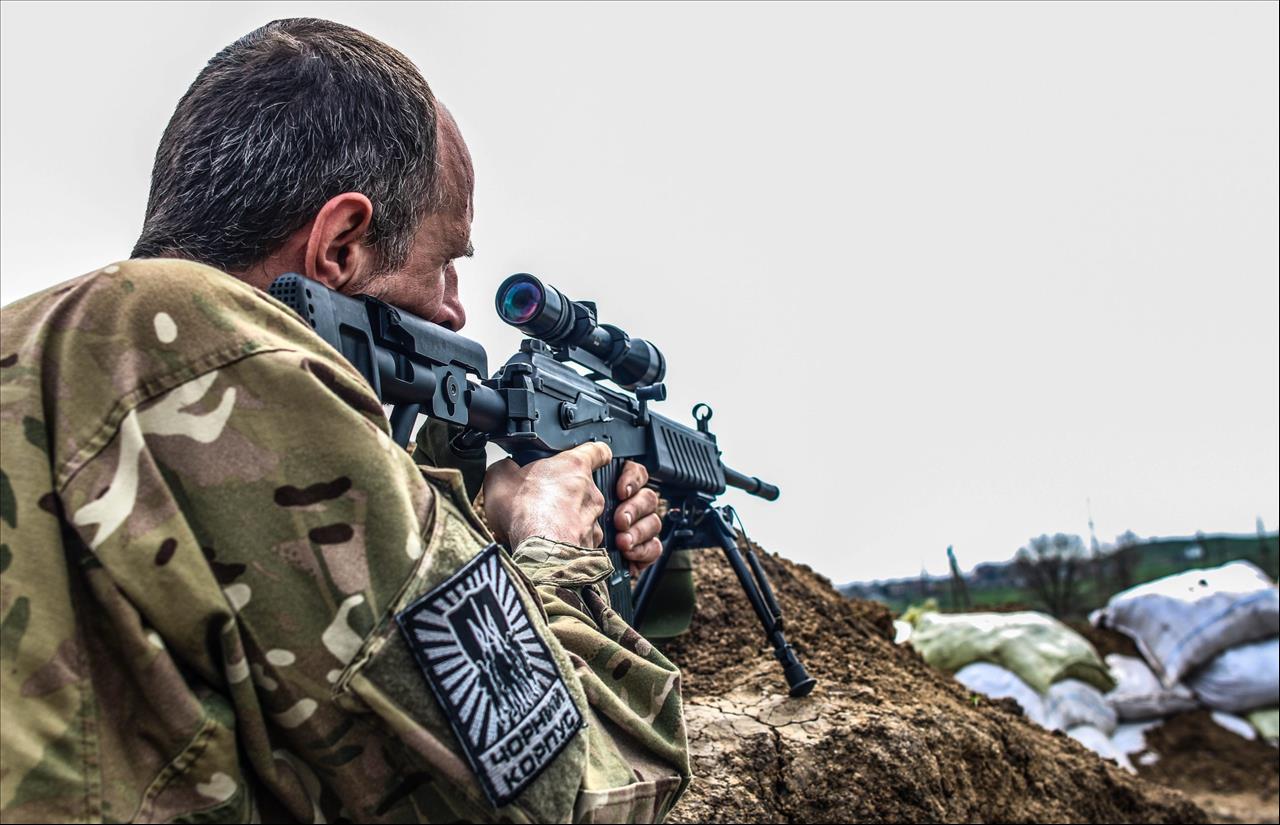
A member of the Azov Battalion, wearing the insignia of Azov's special operations unit, takes aim during combat in eastern Ukraine. Photo: WikiCommons
Azov in action
Amid the ongoing Russian invasion, the natural murkiness that surrounds Azov has been thickened by the fog of war.
It is not even clear how strong the unit is, given its various offshoots. Estimates of its military manpower range between 900 (a battalion) and 3,000 (a regiment or brigade, typically of three battalions).
Snippets of unconfirmed information have leaked out on social media that Azov members are in action nationwide.
Some commentators report that Azov troops were engaged in the successful ambush of a Russian tank column in a settlement east of Kiev, which was captured on a drone camera last week. Others suggest Azov sub-units are also present in besieged Kharkiv.
What seems certain is that Azov is fighting for its home base of Mariupol. A key node in the Azov Sea coastal corridor linking Crimea to Russia proper, it also covers the southern foot of the contested Donbas region. This is making it the focus of perhaps the most intense combat of the war.
German media Krass und Konkret quoted both residents on the ground and Russian reports to allege that Azov members had prevented civilians from fleeing the fighting. The rationale for such a move, presumably, would be to prevent Russian forces from turning the city into a free-fire zone.
That appears to have been superseded this week by an evacuation of some civilians from the embattled city. And the German report admitted:“Both sides maintain strategic communication, ie, only share what is advantageous for them and disadvantageous for the opponents.”
Azov soldiers have – according to an unconfirmed Tweet – greased some of their cartridges with pork fat, a psychological warfare tactic apparently designed to deter Muslim Chechen troops.
The Chechens, who boast a fearsome reputation, have been deployed to Ukraine by Putin ultra-loyalist Ramzan Kadyrov, the strongman who rules Chechnya with an iron grip. Kadyrov has dubbed Ukraine's contemporary defenders“Banderites.”
Yesterday bleeds into today
The multiple references by Putin, Lavrov and Kadyrov to a dark past are emotively explosive for Russians, raising memories of both horror and pride.
The Nazi invasion of the USSR was one of the bloodiest episodes in history – 28 million Soviet people, including millions of Ukrainians, died. But it was the Red Army that destroyed the bulk of the German Wehrmacht.
Putin's Russia, as it stokes Russian nationalism, has leveraged the“Great Patriotic War” to the hilt.
In recent years, a spate of unequivocal films about World War II have appeared, many with state backing.“These films show that Russian filmmakers have been trying to smooth out the country's turbulent history,” wrote online commentator John Phelan.
“The apparent turmoil of Russia's history over the last century is underpinned by a consistent theme of Russian nationalism.”
And as author Keith Lowe notes in Prisoners of History (2020), there has been a spate of historical memorial building – including the world's largest war memorial in Moscow, even bigger than the famous Stalingrad/Volgograd statue, The Motherland Calls.
Despite lacking nuance – such as the anti-Moscow, sovereign impulses of states beyond the Russian heartland – these efforts are hardly unreasonable. And naturally, the SS provides the perfect villains.
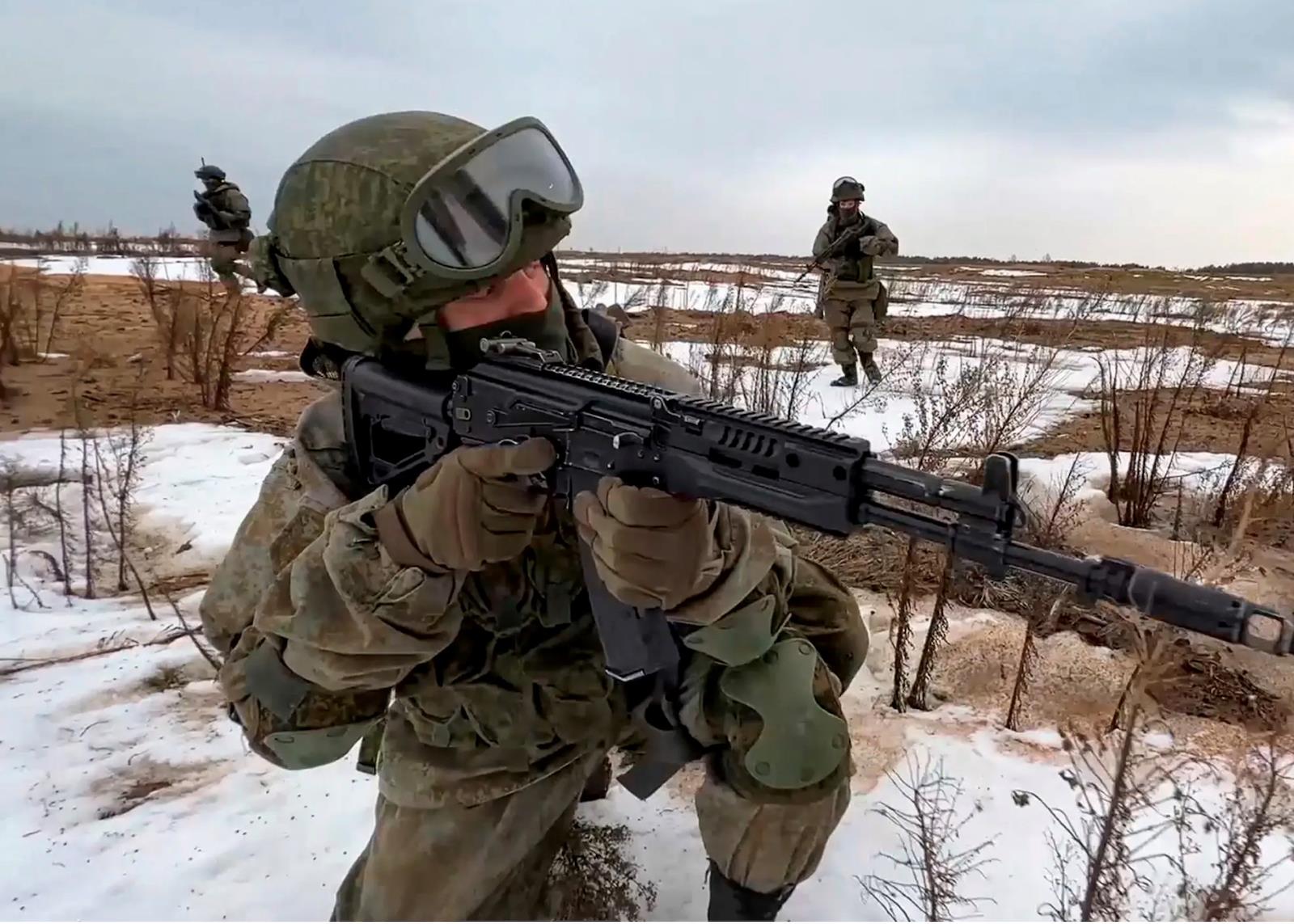
Russian troops training on Ukraine's border in a file photo. Image: Russian Defense Ministry Press Service
“The crimes of the SS were beyond the pale, particularly those committed in Russia during World War II,” said Nash, the military historian.“When the ordinary Russian sees [SS] symbols being used, reason and logic go out the window – it's like a red flag to a bull.”
Yet Putin's invasion may empower the very monster he hopes to destroy.
The Azov movement and related ultra-nationalists are anathema to Russia – and the West. But as the struggle proceeds, they may become subsumed into the far more reasonable and inclusive Ukrainian nationalism that Russia's invasion and Zelensky's leadership is birthing.
And if they do, indeed, fight with the ferocity for which they are known, it may be doubly difficult for post-war, democratic Ukraine to excise them from its military and its body politic.
Follow Andrew Salmon on Twitter: @Andrewcsalmon
MENAFN17032022000159011032ID1103864910